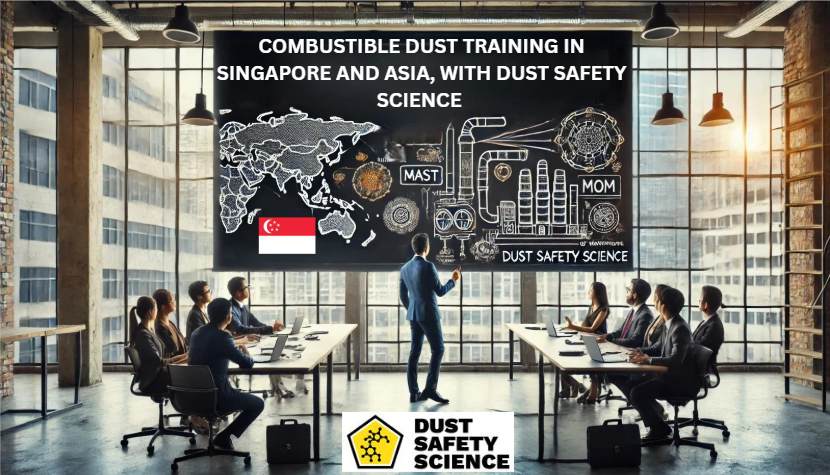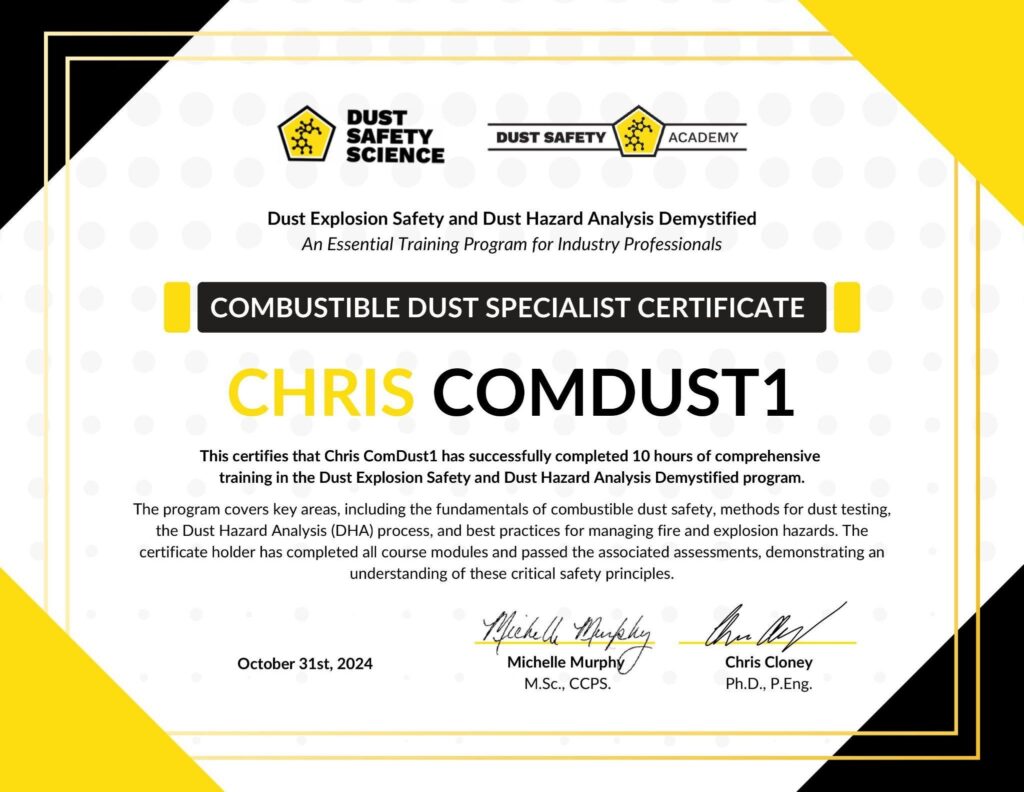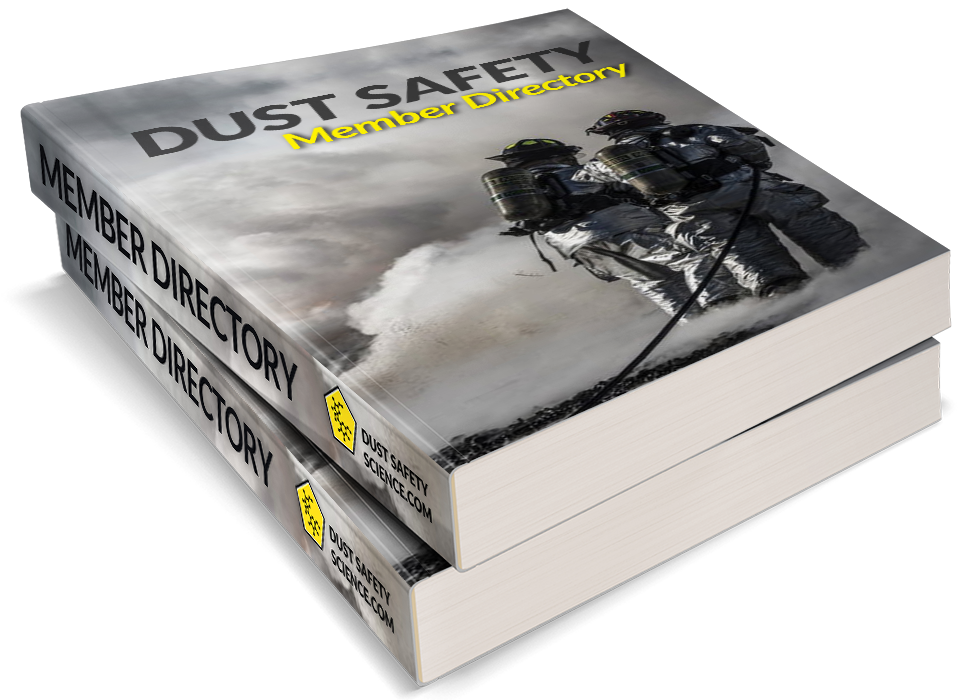Published February 4, 2025 Authored by Dr. Chris Cloney and Jon Barrett of Dust Safety Science

A picture of Combustible Dust Training in Singapore and Asia, with Dust Safety Science
Combustible Dust Training in Singapore and Asia: Ensuring Compliance with MAST and MOM 🌍
Combustible Dust explosions pose a critical safety risk in various industries worldwide, including Singapore and Asia. Industries such as agriculture, food processing, mining, and manufacturing are particularly vulnerable to these hazards due to the abundance of combustible materials and the lack of stringent safety measures. Past and present combustible dust explosions highlight the pressing need for comprehensive safety protocols and combustible dust training to mitigate risks effectively.
Some of the countries in Asia affected by combustible dust explosions include: Afghanistan, Armenia, Azerbaijan, Bahrain, Bangladesh, Bhutan, Brunei, Cambodia, China, Cyprus, Georgia, India, Indonesia, Iran, Iraq, Israel, Japan, Jordan, Kazakhstan, Kuwait, Kyrgyzstan, Laos, Lebanon, Malaysia, Maldives, Mongolia, Myanmar, Nepal, North Korea, Oman, Pakistan, Palestine, Philippines, Qatar, Russia, Saudi, Arabia, Singapore, South Korea, Sri Lanka, Syria, Taiwan, Tajikistan, Thailand, Timor-Leste, Turkey, Turkmenistan, United Arab Emirates (UAE), Uzbekistan, Vietnam, and Yemen.
In this article, we will explore the importance of combustible dust training, highlight the unique online combustible dust training courses of Dust Safety Science, and provide details on worldwide combustible dust training programs with Dust Safety Science.
One of the most effective methods for addressing combustible dust hazards is Dust Hazard Analysis, (DHA). A DHA is a proactive measure to identify potential risks and implement controls to prevent dust explosions. This article explores the importance of dust explosion safety in Latin America, provides an overview of DHA, and emphasizes the need for targeted training programs to enhance industrial safety. Beyond the tragic loss of life, dust explosions can cause extensive property damage, production downtime, and financial setbacks. Combustible dust, produced in manufacturing operations, can ignite under the right conditions, leading to explosions with catastrophic consequences.
Every year, combustible dust explosions and incidents happen across all manufacturing industries, causing widespread destruction, injuries, and even loss of life. The financial toll is staggering, with billions in property damage and legal costs. Despite the risks, many industrial facilities and manufacturing plants must tackle the challenges of combustible dust.
The question is: Are you doing enough to protect your business and employees from dust explosions? To create a safer workplace, visit worldwide combustible dust training programs with Dust Safety Science.
Legal Requirements: Compliance with MAST and MOM
In Singapore, combustible dust hazards fall under the scope of The Multi-Agency Workplace Safety and Health Taskforce, (MAST), and The Ministry of Manpower, (MOM).
The Multi-Agency Workplace Safety and Health Taskforce (MAST), has announced new safety regulations for high-risk machinery and combustible dust, set to take effect on 1 January 2025. This initiative aims to enhance workplace safety and health (WSH) standards, especially in the manufacturing sector, where a significant number of machinery-related accidents have occurred.
The Ministry of Manpower, (MOM)’s data from 2023 revealed that machinery-related incidents accounted for about 14% of fatal and major injuries, with around 60% occurring in the manufacturing sector. Combustible dust hazards also present additional risks of fire and explosion. To address these risks, MOM is introducing enhancements aimed at improving compliance and accountability throughout the supply chain. These measures are part of recommendations by the Inquiry Committee into the 2021 explosion at Stars Engrg, to enhance the existing regime across the supply chain.
According to The Ministry of Manpower, (MOM): Existing requirements under the WSH (General Provisions) Regulations include control measures to prevent an explosion in the workplace arising from explosive or flammable dust. To enhance these measures:
A. Suppliers and occupiers must label packages or containers of combustible dust to state the associated hazards and communicate on its safe use in the workplace. For organic combustible dust such as flour or starch, the labelling requirement applies to packages or containers at 25kg and above.
B. Occupiers need to notify MOM and building owners/landlords if they are handling specified combustible dust at or above the threshold quantity as stipulated in the Fourth Schedule of the WSH (General Provisions) Regulations.
How to Get Started with Combustible Dust and Dust Explosion Training
Whether your organization operates locally or globally, Dust Safety Science has the resources and expertise to help you enhance safety and compliance. Explore Custom Training Solutions or learn more about the Worldwide Training Program.
The Devastating Consequences of Dust Explosions 💥
Combustible dust incidents don’t just cause physical damage, they devastate lives. Workers face injuries or fatalities, businesses lose productivity, and the aftermath often leads to reputational damage and regulatory fines. To address this hidden threat, proactive safety measures are essential. Enter Dust Explosion Safety and Dust Hazard Analysis Demystified Online Training a game changer in industrial safety.
The Need for Combustible Dust Training: Training on Standards and Codes Across Singapore and Asia
Safety training empowers businesses to identify, control, and mitigate combustible dust hazards. A well-structured training program ensures compliance with standards, enhances workplace safety, and promotes operational efficiency. Dust Safety Science has successfully delivered training to industries worldwide, addressing diverse cultural, regulatory, and operational needs. Dust Safety Science’s Worldwide Combustible Dust Training Program is designed to ensure every client receives targeted and effective education.
To take the first step toward creating a safer workplace, visit Dust Explosion Safety and Dust Hazard Analysis Demystified Online Training. The training solutions equip organizations to handle combustible dust risks effectively.
Understanding Combustible Dust Explosions 💥
What is Combustible Dust?
Combustible dust is made of fine particulate solids that can ignite and explode when dispersed in the air. These particles, ranging from wood shavings to powdered metals, form an explosive mix when conditions are optimum.
The Dust Explosion Pentagon identifies five critical elements required for a dust explosion:
- Fuel: Combustible dust.
- Oxygen: Present in the air.
- Ignition Source: Heat, sparks, or flames.
- Dispersion: Particles suspended in air.
- Confinement: Enclosed spaces that amplify explosive force.
When all five elements converge, the results can be catastrophic.
Common Causes of Dust Explosions in Singapore and Asia
- Overheated Bearings: Inadequately maintained equipment is a frequent ignition source.
- Electrical Failures: Faulty wiring, static electricity, or faulty equipment can lead to sparks, including Walkie Talkies, Cell phones, and Microphones.
- Dust Accumulation: Poor housekeeping allows dust to collect and become a serious hazard.
- Smoking: Cigarettes, Cigars, Lighters, Matches.
- Mechanical Malfunctions: Equipment failures can generate heat and friction, igniting dust clouds.
Industries at Risk of Combustible Dust Explosions 🏭
While combustible dust hazards exist in many industries, some industries are more prone to combustible dust explosions than others:
- Food Processing: Soybean, flour, coffee, rice, cotton, beans, cacao, wheat, cocoa, sugar, corn, maize, nuts, and grain dust.
- Woodworking: Sawdust and fine wood particles.
- Pharmaceuticals: Fine powders, plastics, and chemicals.
- Biomass: Wood, wood residues, tobacco, energy crops, agricultural residues. including straw, peat, and organic waste from industry and households.
- Coal: Coal Mines, coal dust, and Coking coal dust.
- Fireworks: Metallic fine dust such as Aluminum, magnesium, titanium, zinc, iron filings, strontium and barium salts
- Metalworking: Aluminum, magnesium, zirconium, and other metallic dust.
Each industry requires customized training to manage unique risks. Learn how tailored training can address these challenges by visiting Dust Explosion Safety and Dust Hazard Analysis Demystified Online Training
Historical Dust Explosion Prevalence in Singapore and Asia
Dust explosions are not limited to any single region or industry, but Singapore and Asia have seen notable incidents over recent decades, emphasizing the need for targeted prevention The potential for incidents exists, especially in agriculture and manufacturing sectors where dust is prevalent. Ongoing research and improved safety standards remain vital to preventing tragedies associated with combustible dust in the region.
Notable Case Studies in Singapore and Asia:
- The New Taipei Water Park Corn Starch Dust Explosion occurred in June 2015, and the event was to simulate India’s Festival of Colours. The dangerously mishandled dust killed 15 people, injured nearly 500 others and caused Taiwan’s largest medical emergency since the 1999 earthquake in Jiji. Cornstarch is considered a combustible dust.
- According to the Voice of America, A dust explosion occurred in the production workshop of Changzhou Shenrong Metal Technology Limited, killing eight people and lightly injuring eight others.
- According to The British Broadcasting Corporation, Kunshan Zhongrong Metal Products Company, which polishes wheel hubs for car makers, had a metal dust explosion. The death toll from the metal dust explosion had risen to 75 and more than 180 other people were hurt in the blast at the car parts factory in Kunshan in Jiangsu province.
- On February 25, 2021, Channel News Asia reported a dust explosion and fire at an industrial building in Tuas, Singapore. Secondary flash fires also occurred which were likely due to the combustion of potato starch powders which were allowed to accumulate at the worksite.
- According to the MDPI, (Multidisciplinary Digital Publishing Institute), research abstract: “Case Studies for Dangerous Dust Explosions in South Korea during Recent Years”: https://doi.org/10.3390/su11184888 Pak, S., Jung, S., Roh, C., & Kang, C. (2019). “This study analyzed the characteristics of 53 dust explosions that occurred in South Korea over the last 30 years, and investigated the differences of dust explosions that happened in various countries, such as Japan, the United States, the United Kingdom, and France. In addition, case studies showed the severity of dust explosions occurring in South Korea.”
- On March 17, 1987, According to the Los Angeles Times, 47 Died, and 179 were injured in a Blast at Linen Mill in Northeast China. The news agency said that an accumulation of flax dust may have set off the explosion. Dense concentrations of dust have been known to spontaneously combust under very dry conditions.
- According to Wikipedia, in 2015 Tianjin explosions occurred with a series of explosions at the Port of Tianjin in Tianjin, Northern China, killed 173 people, according to official reports, and injured hundreds of others. The explosions occurred at a container storage station in the Binhai New Area of Tianjin, China. The cause of the explosions was not immediately known, but an investigation concluded in February 2016 that an overheated container of dry nitrocellulose was the cause of the initial explosion
- According to the Public Broadcasting System News, PBS, Dozens of workers were killed by an explosion inside a coal mine in eastern Iran. An explosion in a coal mine in eastern Iran killed at least 34 workers and injured 17 others, officials said Sunday, marking one of the worst mining disasters in the country’s history as others remained missing hours after the blast.
- On January 20, 2021, the Anadolu Agency reported an explosion at a thermal power plant in Angren, Tashkent Region, Uzbekistan. The explosion was caused by a mixture of coal, dust, and air.
- On November 9, 1963, According to NAKAO, Masayuki (Institute of Engineering Innovation, School of Engineering, The University of Tokyo), a Coal dust explosion occurred at the Mitsui Miike coal mine, in Omuta, Fukuoka, Japan. 458 people were killed and 555 people were injured. It was the worst postwar mine disaster.
- According to a research article in The Extractive Industries and Society, “Coal mine explosions in India: Management failure, safety lapses and mitigative measures.” https://doi.org/10.1016/j.exis.2023.101233 authors: Aashish Sahu, Devi Prasad Mishra, “The use of defective safety lamps and naked lights are identified as the most prominent sources of ignition accounting for 28.21% of total explosions and 53.09% of casualties.”
Combustible dust incidents continue to occur worldwide and in many industries, as presented in this combustible dust research and incident database from Dust Safety Science.
Why Combustible Dust Safety Training is Crucial in Singapore and Asia
Singapore and Asia’s industrial sectors are rapidly evolving, and many countries are expanding their manufacturing capabilities. With industries such as agriculture (grain storage), sugar refining, and mining becoming more prominent, combustible dust hazards are increasing. Without adequate training on combustible dust standards and codes, businesses risk exposure to workplace explosions, environmental damage, and legal consequences.
Key Reasons Why Training is Essential:
- Prevention of Dust Explosions: Combustible dust explosions can cause fatalities, severe injuries, and widespread damage. Proper training helps mitigate the risk of explosions.
- Compliance with Regulatory Requirements: Many countries in South America are enhancing their safety standards, and training ensures businesses meet these evolving requirements.
- Improved Workplace Safety: Employees trained in the hazards of combustible dust are better prepared to recognize risks and implement effective safety measures.
- Reduction in Liability and Operational Costs: Organizations can avoid costly accidents, fines, and downtime by complying with safety regulations and maintaining safe working environments.
Regulatory Compliance in Singapore and Asia
According to Wikipedia, The National Standards of the People’s Republic of China, coded as GB, are the standards issued by the Standardization Administration of China under the authorization of Article 10 of the Standardization Law of the People’s Republic of China. China GB standards — or GuoBiao, meaning “national standard” — provide a standardization framework for all products in the country, from food safety to battery electric vehicles.
The Singapore Safety Statutes provides the Workplace Safety and Health Act, and the Minister for Manpower makes the Regulations.
In Asia, occupational health and safety (OHS) regulations differ significantly from one country to another. In Taiwan, the Occupational Safety and Health Act outlines the OHS regulations and establishes a management system for ensuring safety in the workplace. Meanwhile, in Japan, the Occupational Safety and Health Law mandates that employers provide a safe work environment and implement measures to prevent occupational accidents and diseases.
Regulatory agencies like OSHA and standards like NFPA 652 mandate measures to control combustible dust risks. Failure to comply not only endangers lives but also leads to penalties. Training helps organizations stay compliant and avoid legal consequences.
In addition, NFPA 61, Standard for the Prevention of Fires and Dust Explosions in Agricultural and Food Processing Facilities, protects lives and property from fires and explosions in wheat facilities handling, processing, or storing bulk agricultural materials, their by-products, or other agricultural-related dust and materials.
Risk Mitigation
Identifying and mitigating dust hazards is central to a safe work environment. Training programs, such as those offered by Dust Safety Science, provide actionable insights to reduce risks through Dust Hazard Analyses (DHA) and preventive strategies.
Employee Safety
Education is key to empowering workers. Through training, employees learn to:
- Recognize Combustible Dust Hazards.
- Use properly rated, Combustible Dust Control Equipment, such as Dust Collectors, Dust Control Fans, and Combustible Dust rated Vacuums.
- Use personal protective equipment (PPE) effectively.
- Follow emergency procedures during incidents.
Operational Efficiency
Preventing explosions reduces downtime, maintains productivity, and saves costs associated with accidents. Proper training ensures smoother operations and a safer workplace.
Benefits of Combustible Dust Standards and Codes Training
Investing in specialized training on combustible dust standards and codes brings many benefits, from improving safety and compliance to enhancing overall operational efficiency. Key benefits include:
- Enhanced Safety Culture: Training fosters a safety-conscious work environment and reduces the likelihood of accidents.
- Meeting International and National Standards: Employees become well-versed in global and local combustible dust standards, ensuring compliance with regulatory codes.
- Risk Mitigation: Trained professionals can identify potential hazards early, preventing costly incidents and improving operational continuity.
- Continuous Improvement: Regular training ensures that employees are aware of new codes, emerging risks, and technological advancements in dust management.
Overview of the 2025 Combustible Dust Standards and Codes Training in Singapore and Asia
The 2025 Dust Safety Science Combustible Dust Training Program is a key initiative designed to address the growing need for dust safety expertise in Singapore and Asia. This program provides comprehensive training on combustible dust standards, regulations, and codes specific to the region’s diverse industries.
Training Highlights:
- Expert-Led Sessions: Learn from global experts in combustible dust safety and explosion prevention.
- Localized Content: The program is tailored to meet the unique needs of industries, including agriculture, mining, manufacturing, and more.
- Practical Training: Hands-on exercises and real-world case studies provide participants with the tools they need to assess and address combustible dust hazards.
Who Should Attend?
- Safety Managers
- Plant Engineers
- Industrial Hygienists
- Maintenance Supervisors
- Environmental Health and Safety (EHS) Managers
- EHS, CIH, Process Safety, Engineering, and Fire Science students
- Manufacturing and Factory Personnel
Learn more about the training program: Dust Safety Science Combustible Dust Training Program
Core Elements of Combustible Dust Safety Training
Dust Hazard Analysis (DHA)
A Dust Hazard Analysis, DHA, is the cornerstone of dust safety. A Dust Hazard Analysis involves identifying hazardous zones, evaluating risk severity, and implementing control measures. Training ensures participants can conduct effective DHAs for their facilities.
Housekeeping and Maintenance
Dust accumulation poses a significant risk. Training covers:
- Effective cleaning techniques to minimize airborne dust.
- Preventive maintenance schedules for equipment.
- Targeting hard-to-clean areas where dust tends to settle.
Ventilation and Dust Collection
Proper ventilation and dust collection are critical to control dust at its source. Training addresses:
- Designing effective dust collection systems.
- Ensuring ongoing system inspections and maintenance.
- Educating staff on the proper use of dust collection equipment.
Ignition Source Control
Ignition sources are often preventable. Training programs focus on:
- Identifying ignition risks, such as open flames, hot surfaces, and electrical faults.
- Implementing spark detection and suppression systems.
- Using explosion-proof equipment in high-risk areas.
Emergency Response Planning
When an incident occurs, preparedness can save lives. Training equips workers with:
- Evacuation procedures and drills.
- Fire suppression strategies.
- First aid skills to handle injuries effectively.
Invest in these essential safety components by enrolling in the Dust Safety Science Combustible Dust Training Program
Why Choose Dust Safety Science for Dust Explosion Training?
Comprehensive Curriculum
The Combustible Dust Explosion training program delves deep into combustible dust safety, from understanding explosion mechanics to fundamentals of dust fire and explosion safety and dust hazard analysis. Learn more at Dust Safety Science Combustible Dust Training Program.
Expert Instructors
With a team of seasoned professionals, Dust Safety Science brings unparalleled expertise. Their instructors ensure participants receive actionable, industry-specific guidance.
Flexible Training Options
Choose a format that fits your needs:
- Online Courses: Flexible and accessible.
- In-Person Training: Hands-on experience for practical learning.
- Hybrid Options: A blend of convenience and interactivity
- English, Portuguese, and Spanish subtitles are available
Customized Training Solutions
Every industry faces unique challenges. Dust Safety Science offers tailored training solutions, that address specific risks and compliance needs. Start customizing your training today by visiting Dust Safety Science’s Training Page.
Certificate of Completion
- Certificate of Completion provided after successful completion of a course 🏆
Take Action: Ensure Your Facility’s Safety Today
Combustible dust standards and codes training are essential for ensuring workplace safety in Singapore and Asia’s growing industrial sectors. As regulations evolve and industries expand, businesses must stay ahead of safety requirements to prevent dust explosions, protect workers, and minimize operational risks.
Programs like the 2025 Dust Safety Science Combustible Dust Training Program offer industry-specific, expert-led training to address combustible dust hazards. By leveraging the training, resources, and safety guidelines provided by governmental bodies worldwide, industries can reduce accidents, enhance compliance, and safeguard their workforce.
Don’t wait until it’s too late and register for the 2025 Combustible Dust Standards and Codes Training, visit the: Dust Safety Science Combustible Dust Training Program

A picture of a Sample Certificate of Completion for Combustible Dust and Dust Explosion Course
About Dust Safety Science
Dr. Chris Cloney, of Dust Safety Science provides additional Combustible Dust Incidents in Singapore and Asia with a Podcast. Click on these Podcast Links: Dust Explosion Loss History In Asia and Understanding Chinese National Standards for Explosion Safety

A picture of Dr. Chris Cloney, an Expert on Combustible Dust Hazard Analysis
Resources:
Visit: Dust Safety Science’s Training Page
Visit: Latin America Dust Explosion Safety and Dust Hazard Analysis Demystified Online Training
Visit: Combustible Dust Standards and Codes Training
Visit: Fire and Explosion Protection Equipment Providers
Visit: Risk Assessment & Dust Hazard Analysis Providers
Visit:Combustible Dust Testing Providers
Visit Dust Safety Science (Global Incident Tracking)
Visit Dust Safety Academy (Resources, Training, and Events)
Visit Dust Safety Professionals (Need Help? Get Support Today!)
Visit Dust Safety Journal for the Dust Safety Science Monthly Journal
Subscribe to our FREE, Dust Safety Science Newsletter at Dust Safety Science Newsletter
Visit the Dust Safety Science blog for written articles on combustible dust safety including the latest research, expert opinions, and state-of-the art in fire and explosion protection.
